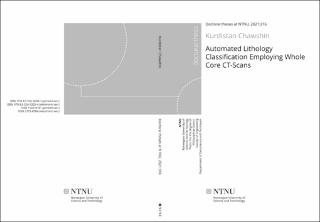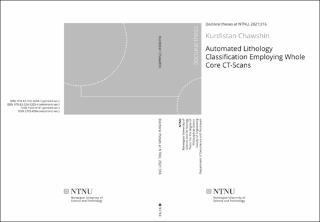| dc.contributor.advisor | Berg, Carl Fredrik | |
| dc.contributor.advisor | Varagnolo, Damiano | |
| dc.contributor.author | Chawshin, Kurdistan | |
| dc.date.accessioned | 2021-09-27T09:23:17Z | |
| dc.date.available | 2021-09-27T09:23:17Z | |
| dc.date.issued | 2021 | |
| dc.identifier.isbn | 978-82-326-5329-4 | |
| dc.identifier.issn | 2703-8084 | |
| dc.identifier.uri | https://hdl.handle.net/11250/2783675 | |
| dc.description.abstract | This thesis evaluates the application of artificial intelligence to detect rock properties from whole core computed tomography (CT) scan images of wells on the Norwegian continental shelf. Whole core CT-scan images provide millimeter scale 3D information on the composition and internal structure of the imaged reservoir rocks.
Lithology classification is crucial to better understand the depositional environment and properties of the reservoir rocks. Reservoir transport properties such as porosity, permeability, and water saturation are closely correlated with lithology through lithological properties. Therefore, lithology classification is an essential step in formation evaluation and reservoir characterization processes. In this thesis, we have evaluated the possibility of automated lithology classification and transport property estimation using whole core CT-scan images, in combination with well logs and routine core analysis data. The automation task was accomplished by application of machine learning algorithms, i.e., support vector machines (SVM) and convolutional neural networks (CNN).
More precisely, three workflows are proposed for classification of lithology. In the first workflow (paper I), first-order statistical features and textural gray-level cooccurrence matrix (GLCM) features are extracted from pre-processed and transformed 2D cross-sectional CT-scan images. These features are then used as an input to train an SVM classifier to classify lithofacies based on ground truth classes that were derived from manual core descriptions. In a second approach in the same paper, a principal component analysis (PCA) step is added before training with two purposes: first, to eliminate collinearity among the features and second, to investigate the amount of information needed to differentiate the analyzed images. The second workflow for lithology classification (paper II) utilizes 2D image slices directly as input to a CNN classifier to learn the relationship between convolution-derived features and expert-derived (manual) lithofacies classes. Finally, the third workflow (paper III) employs the 3D CT-scan images to train a 3D CNN classifier. To evaluate the generalization capabilities of the trained classifiers, they were employed to predict lithofacies classes on a set of unseen images.
The acquired lithology prediction results revealed that SVM and CNN classifiers trained on 2D images show lithology-dependent accuracy, and lithofacies with similarities in the texture and grayscale attenuation values are confused by these classifiers. More importantly, additional analyses of the porosity-permeability trends indicate that misclassified lithofacies share similar transport properties. These findings can be helpful in understanding the similarities between various lithofacies classes and their corresponding transport properties. In paper II the degree of confusion from prediction results and porosity-permeability trends were utilized as a tool to cluster similar lithofacies classes into coarser rock classes as a postclassification step to refine the acquired results. Overall, the obtained lithofacies classification results based on 2D CT images reveal higher performance of the CNN classifier in predicting unseen images compared to the SVM classifier. However, apart from the inherent differences in the statistical generalization capabilities of these algorithms in general, we should consider that these two approaches use different types of data to classify lithofacies. 2D cross-sectional images and the features manually extracted from them might not be completely representative of the 3D variations in core data.
The CNN classifier trained on 3D images (paper III) shows higher generalization capabilities compared to the CNN classifier trained on 2D image slices. This might indicate the added value of the full 3D information for CNN in extracting relevant features and correct identification of lithofacies classes. However, one should note that, due to computational limitations, only a small interval of the well consisting of three (out of twenty) lithofacies classes was used to train the 3D classifier. To ensure a fair comparison, the 3D classifier should have been trained and evaluated on all the lithofacies classes. This was not possible during this PhD study due to lack of enough computational resources.
The possibility of automatic porosity estimation from 2D image slices was also investigated in this thesis (paper IV), where an end-to-end CNN regression model was trained to learn from routine core analysis (RCA) porosity measurements. To characterize the capability of such approach, we compared the performance of this model during training with a linear regression model trained to learn the relationship between the average attenuation of the same 2D images and RCA porosity. The training results showed the superior performance of the CNN model, indicatviing the importance of accounting for the distribution of the gray-level attenuation present in the CT scan images for porosity estimations. The trained CNN model was then used to predict porosity on the unseen images and to populate two wells with millimeter scale porosity values. Comparison of the predicted porosity results against the RCA porosity measurements and total porosity log, calculated from the density log, shows that the predicted porosity values using the proposed CNN model are well correlated with the core plug measurements and porosity log. More importantly, the proposed approach can provide accurate millimeter scale porosity estimations, while the total porosity log is averaged over an interval and do not show such fine scale variations. Thus, the proposed method can be employed to calibrate the porosity logs at the relevant scale, thereby reducing the uncertainties associated with indirect calculations of the porosity from such logs.
In summary, this study confirms the value of whole core CT-scans, as digital representations of the reservoir rocks, in automated lithology classification and transport property estimations. However, there are limitations and uncertainties associated with imbalanced distribution of the lithofacies classes in the training dataset, image artefacts, image complexities and the quality of manual core descriptions that can negatively affect the training process and generalization capabilities of the proposed models. | en_US |
| dc.language.iso | eng | en_US |
| dc.publisher | NTNU | en_US |
| dc.relation.ispartofseries | Doctoral theses at NTNU;2021:316 | |
| dc.relation.haspart | Paper 1:
Chawshin, Kurdistan; Gonzalez, Andres; Berg, Carl Fredrik; Varagnolo, Damiano; Heidari, Zoya; Lopez, Olivier.
Classifying Lithofacies from Textural Features in Whole Core CT-Scan Images. SPE Reservoir Evaluation and Engineering 2021 ;Volum 24.(02) s. 341-357
https://doi.org/10.2118/205354-PA | |
| dc.relation.haspart | Paper 2:
Chawshin, Kurdistan; Berg, Carl Fredrik; Varagnolo, Damiano; Lopez, Olivier.
Lithology classification of whole core CT scans using convolutional neural networks. SN Applied Sciences 2021 ;Volum 3.(6) s. 1-21
https://doi.org/10.1007/s42452-021-04656-8
This article is licensed under a Creative Commons Attribution 4.0 (CC BY 4.0) | |
| dc.relation.haspart | Paper 3:
Chawshin, Kurdistan; Berg, Carl Fredrik; Varagnolo, Damiano; Lopez, Olivier.
A Deep-Learning Approach for Lithological Classification Using 3D Whole Core CT-Scan Images. I: SPWLA 62nd Annual Logging Symposium.
https://doi.org/10.30632/SPWLA-2021-0029 | |
| dc.relation.haspart | Paper 4:
Chawshin, Kurdistan; Berg, Carl Fredrik; Varagnolo, Damiano; Lopez, Olivier.
Automated Porosity Estimation using CT-scans of Extracted Core Data. | |
| dc.title | Automated Lithology Classification Employing Whole Core CT-Scans | en_US |
| dc.type | Doctoral thesis | en_US |
| dc.subject.nsi | VDP::Technology: 500 | en_US |
| dc.subject.nsi | VDP::Technology: 500::Rock and petroleum disciplines: 510::Mineral resources engineering: 511 | en_US |

